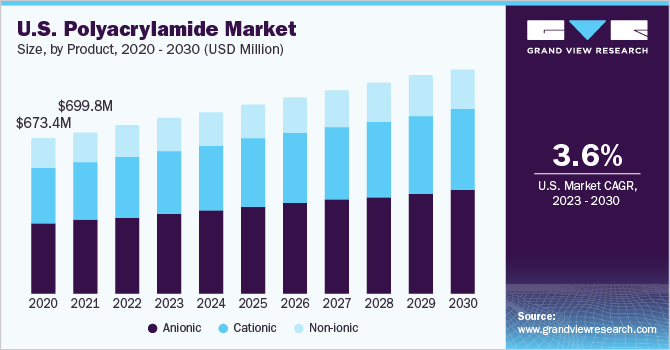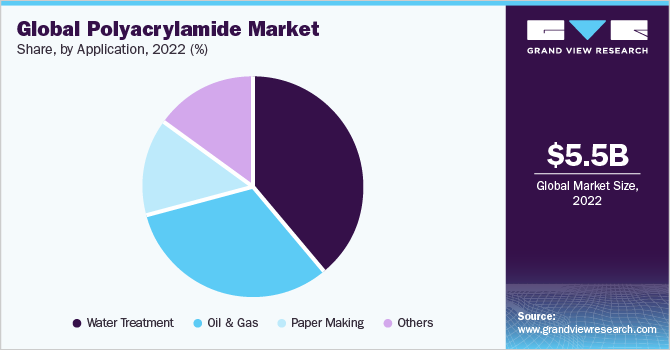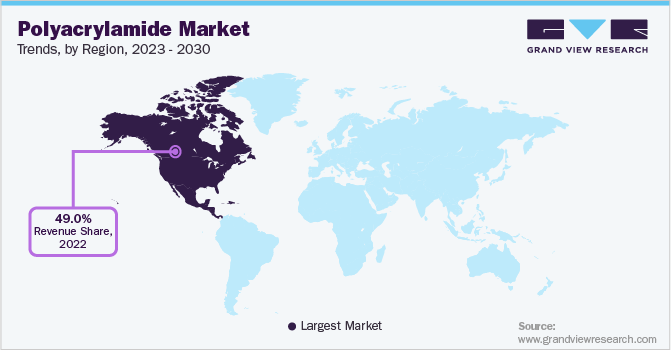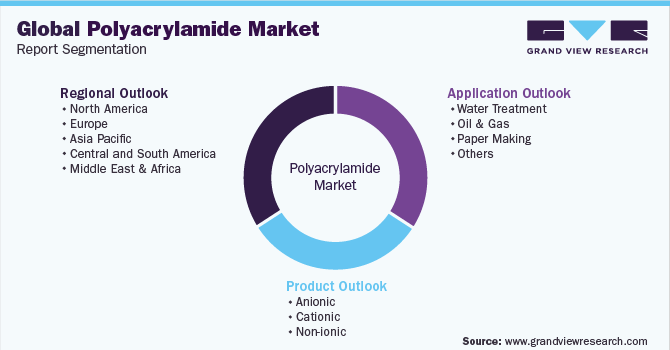- Home
- »
- Plastics, Polymers & Resins
- »
-
Polyacrylamide Market Size, Share & Growth Report, 2030GVR Report cover
![Polyacrylamide Market Size, Share & Trends Report]()
Polyacrylamide Market Size, Share & Trends Analysis Report By Product (Cationic, Anionic), By Application (Water Treatment, Oil & Gas), By Region (Asia Pacific, North America), And Segment Forecasts, 2023 - 2030
- Report ID: 978-1-68038-944-9
- Number of Report Pages: 120
- Format: PDF, Horizon Databook
- Historical Range: 2018 - 2021
- Forecast Period: 2023 - 2030
- Industry: Bulk Chemicals
Polyacrylamide Market Size & Trends
The global polyacrylamide market size was estimated at USD 5.5 billion in 2022 and is projected to grow at a compound annual growth rate (CAGR) of 6.5% from 2023 to 2030. The growing demand for the product across various application industries including wastewater treatment, oil recovery, paper-making, and food & beverage is expected to propel the industry growth. Abundant raw material availability, low labor, and land cost coupled with high consumption in the Asia Pacific region are likely to compel manufacturers to set up their production plants in this region. However, the presence of numerous Chinese manufacturers, which offer their products at relatively lower prices are expected to be key threats for the new entrants.

As a result, cost competitiveness is likely to be the key criterion for influencing buyers’ decisions. The industry is dominated by multinationals including SNF Group, CNPC, BASF, and Kemira, which accounted for over 50% of the overall market. These multinationals have a direct and indirect distribution system for the product supply in the domestic as well as international market. In addition, companies are expected to increase their production volumes to tap the rising demand across the globe.
The U.S. market is expected to grow owing to the growth of water treatment, paper-making, and mining industries. The regulations and amendments on wastewater treatment by the U.S. Environmental Protection Agency (EPA) and Safe Drinking Water Act (SDWA), are expected to propel demand for water treatment chemicals, impacting the industry on a positive note. The polyacrylamide prices are directly dependent on the cost of raw materials including acrylic acid and acrylonitrile, which are derived from crude oil.
Increasing crude oil prices are likely to raise raw material pricing in the industry, resulting in upward trends in the polyacrylamide price trends over the next seven years. The major manufacturers, such as SNF and BASF, have brand values and strategic partners, which enable easy marketing of their products. The manufacturers are likely to improve product quality and invest more in R&D to reduce the overall polyacrylamide cost to tap the growing demands.
Product Insights
Anionic and cationic polyacrylamide polymers were the dominant product segments, accounting for more than 78.0% of the overall demand in 2022. Anionic polyacrylamide polymers are used in applications including wastewater treatment, pulp and paper industry, aquaculture, food & beverage, coal mining, food & beverage, and oil & gas industries. The anionic polyacrylamide polymers have a high demand for industrial wastewater treatment and municipal sewage treatment as flocculating agents. The increasing impure water discharge from industries, and growing scarcity of potable water, is expected to drive demand for polyacrylamide in water treatment application over the coming years.
Also, the growing product demand in other application areas, such as coal washing, mineral processing, metallurgy, iron & steel, and electronic industries, will support segment expansion. The demand for cationic polymers was significant in 2022 owing to their high usage as retention and drainage aids in papermaking and flocculants in wastewater treatment. These polymers act as stabilizers for emulsion polymerization in cosmetics. The aforementioned factors are expected to open new avenues for market growth over the coming years.
Application Insights
Polyacrylamide demand in water treatment applications dominated the market with a revenue share of more than 38.0% in 2022. The rising demand for polyacrylamide to treat municipal sewage, industrial wastewater, and drinking water purification plants is expected to propel demand. Furthermore, increasing attention to the water treatment industry by government regulatory bodies across various countries is likely to have a positive impact on market growth. The demand for the product from the oil & gas industry for enhancement of oil recovery is expected to grow over the forecasted period as the product improves the oil recovery efficiency.

Also, it is used in drilling mud and fracturing fluid additives. The use of polyacrylamide can adjust the drilling fluidity, carry shale debris, lubricate the drill bit, and control fluid loss. The aforementioned factors are expected to drive product demand in oil & gas applications. In the paper-making industry, it works as a retention agent and improves paper quality. As a result, the demand in paper-making applications will grow significantly over the forecast period. Furthermore, it acts as the dispersing agent and helps in reducing fiber flocculation to improve the paper formation process.
Large-scale paper manufacturing for various applications including educational material and packaging, coupled with rising product adoption in the pulp & paper manufacturing process, will drive the segment growth. It is considered an important variable in the mining process, as it effectively separates the solid mineral from the water or solution and this improves the drilling efficiency. The product is widely used in the coal manufacturing industry for the coal washing process. Rising mining activities, coal washing, metal plating, and dying are expected to drive segment growth over the forecast period.
Regional Insight
In North America, the demand for the product is dominated by the water treatment application, which accounts for over 49.0% of the overall demand in 2022. Stringent regulatory actions against wastewater disposal coupled with the rising environmental concerns in the region are expected to drive water treatment activities, which are likely to have a positive impact on the industry’s growth. Furthermore, developments of polyacrylamide polymers for producing polyacrylamide gel and powder are expected to create new avenues in bio-sciences and pharmaceuticals in the region. Asia Pacific also accounted for a considerable share in 2022. China accounted for the major share of the market and is expected to grow at a significant CAGR over the forecast period.

The robust base of the pharmaceutical and chemical manufacturing industries in the region has resulted in a high volume of wastewater, which will propel the product demand as water treatment chemical. In addition, the region is one of the top pulp & paper manufacturing markets in the world. Thus, the presence of several pulp & paper manufacturers, such as Shandong Pulp & Paper Co., Ltd., will have a positive impact on the industry growth. The product demand in Germany was significant in 2022 and will grow at a lucrative CAGR from 2023 to 2030. The country is the largest EU water technology exporter in Europe. Also, high investments in water recycling and purification technology are expected to drive product demand in water treatment activities.
Key Companies & Market Share Insights
Manufacturers are expected to invest more in capacity expansion to strengthen their position in the industry and meet the rising consumer demand. For example, in 2015, SNF Holding expanded its production capacity by building a new plant in Louisiana to expand the product business in the domestic as well as international market. Some of the key players in the global polyacrylamide market include:
-
Anhui Jucheng Fine Chemical Co, Ltd. (CJCC)
-
Ashland Inc.
-
BASF SE
-
Kemira
-
SNF Group
-
Black Rose Industries Ltd.
-
Shandong Polymer Bio-Chemicals Co., Ltd.
-
Xitao Polymer Co., Ltd.
-
ZL EOR Chemicals Ltd.
-
Dongying Kechuang Biochemical Industrial Co., Ltd.
Polyacrylamide Market Report Scope
Report Attribute
Details
Market size value in 2023
USD 5.8 billion
Revenue forecast in 2030
USD 9.1 billion
Growth rate
CAGR of 6.5% from 2023 to 2030
Base year for estimation
2022
Historical data
2018 - 2021
Forecast period
2023 - 2030
Quantitative units
Volume in kilotons, revenue in USD million/billion, and CAGR from 2023 to 2030
Report coverage
Revenue forecast, volume forecast, company ranking, competitive landscape, growth factors, and trends
Segments covered
Product, application, region
Regional scope
North America; Europe; Asia Pacific; Central & South America; Middle East & Africa
Country scope
U.S.; Germany; U.K.; China; India; Japan; Brazil
Key companies profiled
Anhui Jucheng Fine Chemical Co, Ltd. (CJCC); Ashland Inc.; BASF SE; Kemira; SNF Group; Black Rose Industries Ltd.; Shandong Polymer Bio-chemicals Co., Ltd.; Xitao Polymer Co., Ltd.; ZL EOR Chemicals Ltd.; Dongying Kechuang Biochemical Industrial Co., Ltd.
Customization scope
Free report customization (equivalent up to 8 analysts working days) with purchase. Addition or alteration to country, regional & segment scope
Pricing and purchase options
Avail customized purchase options to meet your exact research needs. Explore purchase options
Global Polyacrylamide Market Report Segmentation
This report forecasts revenue growth at global, regional, and country levels and provides an analysis of the latest industry trends in each of the sub-segments from 2018 to 2030. For the purpose of this study, Grand View Research has segmented the global polyacrylamide market report on the basis of product, application, and region:

-
Product Outlook (Volume, Kilo Tons; Revenue, USD Million, 2018 - 2030)
-
Anionic
-
Cationic
-
Non-ionic
-
-
Application Outlook (Volume, Kilo Tons; Revenue, USD Million, 2018 - 2030)
-
Water Treatment
-
Oil & Gas
-
Paper Making
-
Others
-
-
Regional Outlook (Volume, Tons; Revenue, USD Million, 2018 - 2030)
-
North America
-
U.S.
-
-
Europe
-
Germany
-
U.K.
-
-
Asia Pacific
-
China
-
India
-
Japan
-
-
Central & South America
-
Brazil
-
-
Middle East & Africa
-
Frequently Asked Questions About This Report
b. The global polyacrylamide market size was estimated at USD 5.5 billion in 2022 and is expected to reach USD 5.8 billion in 2023.
b. The global polyacrylamide market is expected to grow at a compound annual growth rate of 6.5% from 2023 to 2030 to reach USD 9.1 billion by 2030.
b. Anionic segment dominated the polyacrylamide market with a share of 43.9%. Anionic polyacrylamide polymers are used in applications including wastewater treatment, pulp and paper, aquaculture, coal mining, food and beverage, and oil and gas industries.
b. Some key players operating in the polyacrylamide market include SNF, BASF, CNPC, Ashland, Kemira, Anhui Jucheng Fine Chemical Co, Ltd. (CJCC), Black Rose Industries Ltd., Shandong Polymer Bio-chemicals Co., Ltd., Xitao Polymer Co., Ltd., and Anhui Tianrun.
b. Key factors that are driving the market growth include rising demand for the product from the oil and gas industry for the enhancement of oil recovery.
Share this report with your colleague or friend.
![gvr icn]()
NEED A CUSTOM REPORT?
We can customize every report - free of charge - including purchasing stand-alone sections or country-level reports, as well as offer affordable discounts for start-ups & universities. Contact us now
![Certified Icon]()
We are GDPR and CCPA compliant! Your transaction & personal information is safe and secure. For more details, please read our privacy policy.
We are committed towards customer satisfaction, and quality service.
"The quality of research they have done for us has been excellent."





